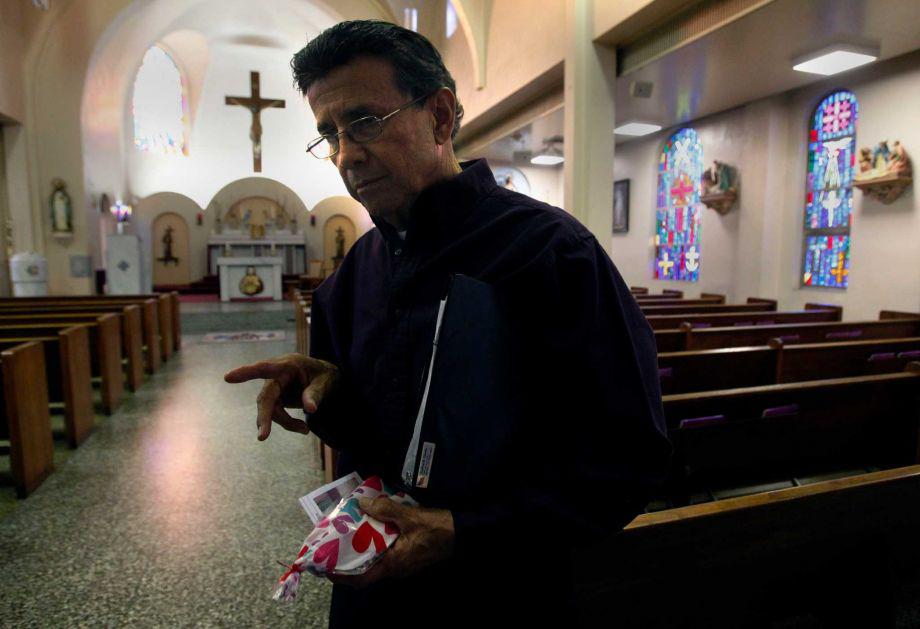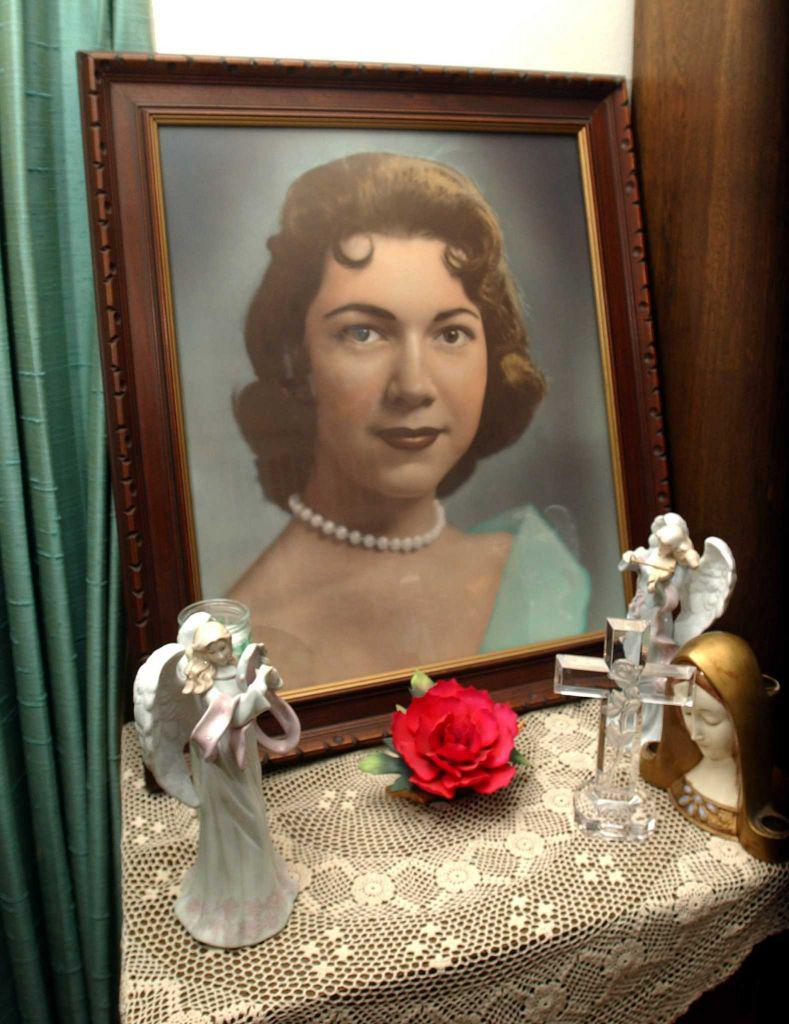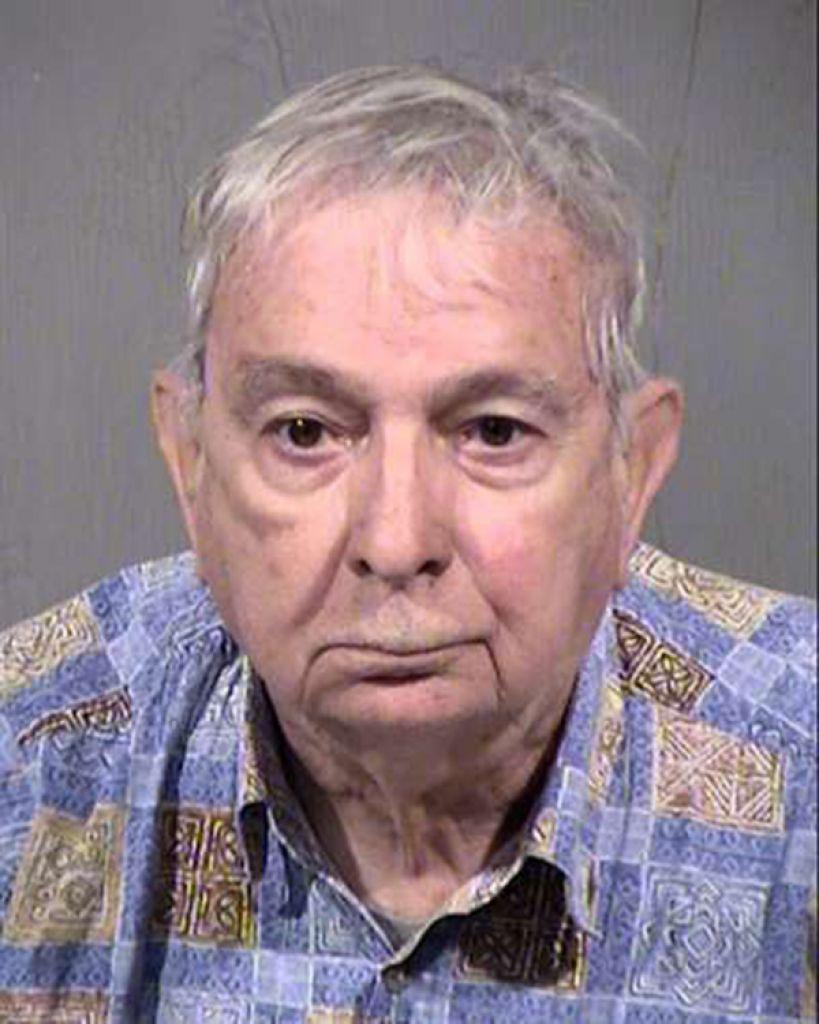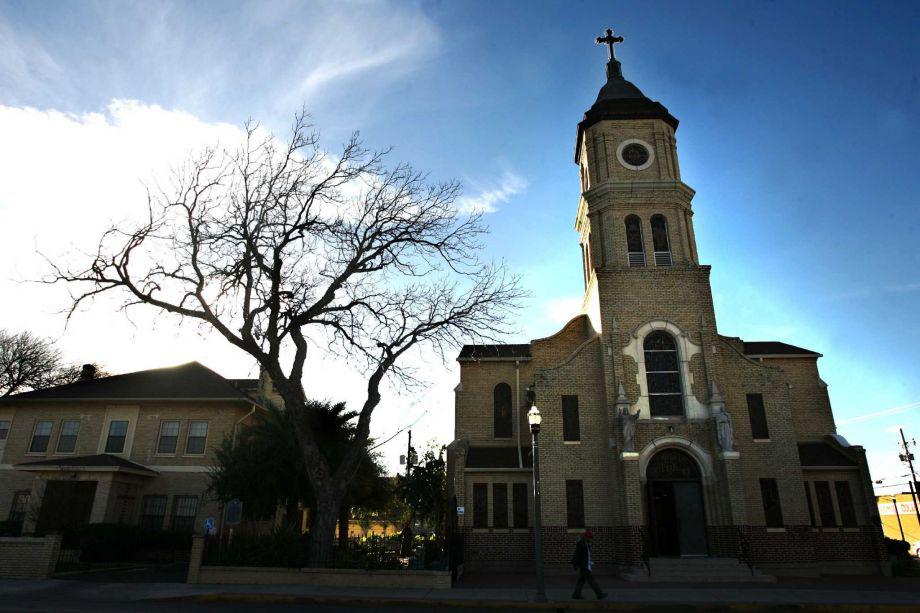|
A community hopes for closure after arrest of priest in 1960 killing of beauty queen
By Lynn Brezosky
McALLEN — A greeter at Sacred Heart Catholic Church, Peter Pranis straightens with pride when asked about the stately brick sanctuary, its bell tower rising above downtown and its panels of stained glass that soften the rays of the harsh South Texas sunlight. But when asked about what allegedly happened inside the basement of the church rectory 56 years ago, his tone flattens to a near whisper. “People are very reluctant to talk about it,” Pranis said of the 1960 sexual assault and slaying of Irene Garza, a 25-year-old schoolteacher and former beauty queen who arrived at the church to say confession and was never seen again. “It is very raw.” Earlier this month, long after many parishioners had lost hope of a resolution in the high-profile case, authorities in Arizona arrested a former priest and charged him with Garza’s death. John Feit, now an old man at 83, is being held on a $750,000 bond while awaiting an extradition hearing scheduled for Wednesday. For decades, Rio Grande Valley residents had suspected that Feit, who has long maintained his innocence and is now a grandfather living in a retirement community in Arizona, had played a role in Garza’s disappearance and choking death. A slide projector that belonged to him was found near Garza’s body, and blood-stained pants that belonged to a Sacred Heart priest were laundered at a nearby dry cleaning business shortly after the killing. Speculation persisted, even after Feit left town and the priesthood. Garza’s body was found about a week later. Shortly afterward, the investigation went cold. But the mystery surrounding her death was never far from anyone’s minds, and persisted in the upper Rio Grande Valley’s collective memory. “The whole community was stopped dead in its tracks,” said James McAllen, a prominent rancher whose family is the namesake of the city and who was 15 at the time of the killing. “It was the talk of the street…where everyone said, ‘Ah, the church has ways of taking care of that.’ Maybe the church was not involved, but that was the talk.” The case was reopened in the early 2000s, only to have a grand jury in 2004 decline to indict. McAllen Police Chief Victor Rodriguez said he understands how such a case can become embedded in a community. In the end, the department wanted nothing more than to solve it. “I think first and foremost this is about, ‘We’re doing our job,’” Rodriguez said. “It’s only different because of the gravity of the case, number one, and number two how old the case is. And the third and probably most alarming component is that the suspect is a member of the church.” While he couldn’t talk about evidence in the case, Rodriguez said the arrest should bring a sense of closure to the church community and Valley. “Questions that may have lingered with them for years and years and years now have a prospect of being answered,” he said. “Many people will put this in all different terms, closure and relief and all those things, but really what it means is the community is the better for it. “Now we’ve turned the page and (we’re) on to a next chapter in the case,” he continued. “And maybe in that chapter all of the community’s questions will be answered. Maybe we’ve reached the end of this event.” Most of Garza’s immediate relatives died not knowing whether anyone would ever be arrested. Lynda de la Viña, a first cousin, said in a statement that the family is “overwhelmed with the news” and stands “united after 56 years in the pursuit of justice for Irene.” “Proverbs 25:2 (King James Bible) says it is the Glory of God to conceal a thing, but the honour of kings is to search out a matter,” de la Viña said in a statement to The Monitor, McAllen’s newspaper. “In other words, nothing can be hidden from God, but it is the honour of rulers to bring to light hidden works of darkness.” Feit was indicted this month after evidence was presented to a grand jury by Hidalgo County District Attorney Ricardo Rodriguez, who campaigned two years ago on a promise to reopen this case. According to the indictment, the grand jury concluded Feit, with “malice aforethought” caused Garza’s death by asphyxiation. Feit had been a priest at Sacred Heart for a few years when Garza arrived during Holy Week to say confession. The former priest, 27 at the time, heard her confession and later said he last saw Garza standing outside the church. Her disappearance sparked a massive manhunt, and a few days later authorities fished her body from an irrigation canal. Her blouse was unbuttoned and she was missing her shoes. One shoe had already been found on a nearby road. Her purse had been found in a field. And the green slide viewer that belonged to Feit was found in the canal. She had been bludgeoned and suffocated and an autopsy revealed she had been raped while in a coma. Last week, after Saturday evening mass, parishioner Carlos Cantu, 77, pulled out a picture of Garza wearing a pageant dress sewn by his mother Eva, a seamstress who also made Garza’s high school drum majorette uniform. Garza was his neighbor, he said, and played a role in his religious path. “For my first communion, they had girls 12 and 13 years old, they would be angels,” he said. “She was my angel.” He also remembered Feit, and of stories like how the priest allegedly waved off a question about apparent bite marks on his hand by saying it had been caught in a mimeograph machine. “Time passes,” he said, “but people always believed like myself that something should have been done, that there was a lot of evidence to go around.” In a separate case in nearby Edinburg, just a few weeks before Garza’s disappearance, Feit was accused of assaulting a 20-year-old woman at a different Sacred Heart Catholic Church. The woman told police that she bit his fingers and that he had run away, although she was able to identify her perpetrator. After a jury trial ended in mistrial, Feit pleaded no contest to aggravated assault and was fined $500. Rene Guerra, the former district attorney whose 2004 case against Feit was no billed, said this month’s indictment was the result of a political promise to bring justice on a case that had only hearsay and a compilation of “crappy” material from investigators. He questioned the timing of the arrest, which came as Mexicans were preparing for the visit of Pope Francis. “They’re not going to get any new evidence, there’s no new technology, no forensics,” he said. “It was highly touted that he was going to indict but in the long run nobody’s going to benefit. ... A D.A. can indict a ham sandwich in South Texas, but I never worked that way in 33 years. We didn’t want bad cases.” Guerra has been maligned in the media for not calling Feit or Dale Tacheny, a former priest who claimed in a report to San Antonio police that Feit once confessed to a crime that resembled the Garza case, to testify during the grand jury proceedings. Guerra said he tasked two lieutenants with presenting everything they had in the case over 15 weeks of testimony. If called to the stand, Feit would have invoked his Fifth Amendment right against self-incrimination and not said anything, Guerra said. As for Tacheny, Guerra said he didn’t believe him. Edinburg Mayor Richard Garcia, a federal criminal law attorney and Valley native who graduated from high school four years after Garza’s slaying, said the case isn’t political. “I think the family’s been fighting for a very long time to get something resolved,” he said. “I don’t think this is about the pope,” he added. “They’re not indicting the Catholic church. This is about an individual and he (Guerra) better than anyone knows how slowly the wheels of justice turn.” If a conviction is secured, old-fashioned gumshoe reporting may have played a role. Reporters like Emma Perez-Treviño, who in the early 2000s was a reporter with the Brownsville Herald, was looking for a local story as news of pedophilia within the Catholic priesthood was spreading from Boston. While researching, she found a story from years before that mentioned a cold case featured on an internal McAllen Police Department television show and obtained a copy of the segment. It was about the investigation into Feit’s possible role in the Garza case, and it mentioned that Feit had passed a polygraph test. She eventually found George Lindberg, the man who had administered the test and who had since risen to become a federal judge in Chicago. “He remembered it as if it were yesterday, that’s the sense I got,” Perez-Treviño said. He told her, however, that Feit had not passed the test, which was later ruled inconclusive. More leads turned up. An investigator who years earlier had failed to get the case reopened told her he was glad someone was looking into it. She also talked to a witness who remembered being in class with Feit at the local university (at the time, priests were sent to the then-Pan American College to learn Spanish) and seeing scratches on his arms. In 1960, the parish was part of the Diocese of Corpus Christi, which told her they had no information on Feit. “They buried everything,” she said. “And in my opinion it had to go all the way up.” She found out that Feit after pleading no contest in the March 1960 assault case had been sent to the Servants of the Paracletes in Jemez Springs, New Mexico, where he became a director of a program for troubled priests before leaving the church, getting married, and having children. She found Feit in Arizona. She called him. “I said, ‘Father, is that you?’ And I knew he was no longer a priest, but it was very difficult for me to write the story in that sense because I hadn’t realized how strongly the church was engrained in me,” she said. Perez-Treviño describes herself as a Catholic who is not heavily religious in the church-going sense but who is devout. Her home is full of religious symbolism, and she recalled tears streaming down her face as she covered the canonization of Juan Diego in Mexico City in 2002. She said she could only imagine how Garza’s death, and speculation that a priest was involved, affected Valley Catholics in 1960. “It was physically, emotionally draining,” she said. “I even sat on the story… I couldn’t believe that priests could do this or could be a suspect…and that he ended up being a superior at the organization for troubled priests.” Later, various news organizations reported that Feit had allegedly confessed to fellow priests, Tacheny and Father Joseph O’Brien, Sacred Heart’s pastor at the time of the killing. Both priests gave statements to police. Feit denied killing Garza. “He said, ‘If you are asking me if I am the man that killed Irene Garza, I am not that man. I did not kill her,’” she said. It wasn’t long before more news agencies picked up the old case. Kristine Galvan, who in 2003 was a television reporter with the local ABC affiliate KRGV News, obtained the case file, which had been gathering dust at the Hidalgo County courthouse. The item that most intrigued her was the Eastman Kodaslide viewer Feit had purchased in Port Isabel that was found in the canal where Garza was found. Galvan headed to Arizona with a photographer to knock on Feit’s door, camera rolling. After he opened the door and confirmed who he was, Galvan asked if he had killed Irene Garza. “Thank you for asking that wonderful question,” Feit said before closing the door. “Have a good day.” Noemi Sigler, an Edinburg woman who identifies herself as a relative of Garza’s, started sending Galvan’s segment around, almost like a press release to draw attention to the case, Galvan said. “It just snowballed after that,” Galvan said. “And then there was a lot of pressure on the district attorney, ‘Why won’t you even send it to a grand jury?” “He is innocent until proven guilty,” she added of Feit. “I will tell you that people are asking me, ‘Don’t you feel sorry for him? He’s old and he’s on a walker and look at the way he’s handcuffed?’. ... If he did this, I don’t feel sorry for someone who murders.” Michelle Zamora’s grandparents were interviewed by Texas Rangers during the reopened investigation in the early 2000s because they had the dry cleaning business for the church and remembered taking in a priest’s blood-stained pants. Zamora was an infant at the time, and like other Valley residents knew about the case even if it was rarely discussed. “I think it was put on the back burner,” she said. “Out of sight, out of mind.” Sacred Heart, the oldest continuously operating church in the heart of the old downtown of the Texas-Mexico border city, has been a big part of her life, she said, and she’s angry with the Catholic Church for not taking serious action against Feit in the 1960s. “I was baptized there, made my first communion there, I was married there, I went to catechism there,” she said. “We’ve always surrounded our lives around that church because that’s what we knew.” Still, Zamora is among those who now see Feit as a feeble old man. “I mean I feel bad for the man, he can barely freaking walk. What are they going to do? Throw him in jail for the rest of his life so he becomes a burden to society?” she said. “If he did this, he’s got his own cross to bear. If he still believes in God, God is going to meet him at the Pearly Gates and say yes or no.” Contact: lbrezosky@express-news.net
|
.
Any original material on these pages is copyright © BishopAccountability.org 2004. Reproduce freely with attribution.



